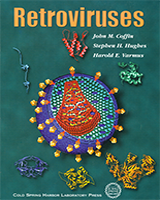NCBI Bookshelf. A service of the National Library of Medicine, National Institutes of Health.
Coffin JM, Hughes SH, Varmus HE, editors. Retroviruses. Cold Spring Harbor (NY): Cold Spring Harbor Laboratory Press; 1997.
The retroelements are as diverse an assemblage of related molecular entities as can be found anywhere. With the exception of the retroviruses themselves, retroelements are genetic parasites that inhabit the genomes of all eukaryotes and many prokaryotes. The infectious retroviruses can be considered a highly evolved pinnacle on the complex phylogenetic tree that makes up the retroelements. The root of this tree is believed by many to be an ancient cellular reverse transcriptase gene, as originally proposed by Temin (1980), although this remains controversial.
It is useful to consider the retroelements in comparison to the infectious retroviruses. The retroelement types, summarized in Table 1, include the endogenous retroviruses, the retrotransposons, the “retrotranscripts” (including the Alu-like sequences and the processed pseudogenes), and the prokaryotic retrons (also known as multicopy single-stranded DNAs [msDNAs]). Retroelements are known primarily as mobile DNA species integrated at various positions in the genomes of their host species, although most of them also have important extrachromosomal DNA forms. From the mitochondrial and chloroplast compartments of various organisms, the mobile group II introns (referred to here as retrointrons) and the retroplasmids are recognized as retroelements. Yet another major grouping of retroelements is the “pararetroviruses,” a group of true viruses with DNA genomes that, in a curious permutation of the retroviral life cycle, replicate via a cellular RNA intermediate but do not normally integrate into the host genome.
Table 1
Retroelement Nomenclature.
The molecular thread interweaving this complex phylogenetic tapestry is the copying of RNA into DNA during a step in the life cycle of each of these organisms. This process is carried out by reverse transcriptase (RT), in most cases encoded by the retroelement but, in a few cases, such as the retrotranscripts, “borrowed” from another retroelement. As will be seen in this chapter, there can be many diverse and distinct embellishments on the basic retro-lifestyle. The diversity of the retroelement group as well as its pervasiveness throughout the genomes of all major taxa argues for an ancient origin. This jives well with the notion that RT originally appeared during the early “RNA world.” Presumably an RT originally served an important archiving function once the transition was made from the storage of genetic information in the enzymatically flexible, but chemically more volatile, RNA form into the relatively stable DNA form. Alternatively, given the great diversity of RT sequences, the possibility of independent evolution of RT must also be considered. Although a plausible argument can be made for the evolution of RT from a single ancestor by phylogenetic tree analysis, the depth of the branches on this tree make the origin of the enzyme murky, especially considering its likely antiquity and known rapidity of evolution. Regrettably, the diversity of retroid life forms has also spawned a plethora of nomenclatures (Gabriel and Boeke 1993). In this chapter, the terms defined in Table 1 will be used.
In the modern world, genes encoding RT live on in a multiplicity of retroelement forms that encompass so much diversity that it is doubtful whether all major forms of retroelements have yet been discovered. In addition to the parasitic retroelements, at least one “cellular” form of RT persists in the form of telomerase, an unusual form of DNA polymerase that performs an essential cellular role: the synthesis of telomere DNA using an intrinsic RNA template. Telomerases are ribonucleoprotein enzymes containing a species-specific RNA sequence. This RNA templates the synthesis of a repeat sequence that is added on to the 3' end of chromosomes to counteract sequence loss during lagging-strand synthesis (Blackburn 1992). This chapter compares other retroelements to retroviruses, focusing on the replication processes of these elements and emphasizing differences from the retroviruses whenever possible.
- Review Ribonuclease H evolution in retrotransposable elements.[Cytogenet Genome Res. 2005]Review Ribonuclease H evolution in retrotransposable elements.Malik HS. Cytogenet Genome Res. 2005; 110(1-4):392-401.
- Review Retroelements, reverse transcriptase and evolution.[Comp Biochem Physiol B Biochem...]Review Retroelements, reverse transcriptase and evolution.Flavell AJ. Comp Biochem Physiol B Biochem Mol Biol. 1995 Jan; 110(1):3-15.
- Review The unusual phylogenetic distribution of retrotransposons: a hypothesis.[Genome Res. 2003]Review The unusual phylogenetic distribution of retrotransposons: a hypothesis.Boeke JD. Genome Res. 2003 Sep; 13(9):1975-83.
- Review Retrotransposons.[Curr Biol. 2012]Review Retrotransposons.Finnegan DJ. Curr Biol. 2012 Jun 5; 22(11):R432-7.
- Review LINEs, SINEs and processed pseudogenes: parasitic strategies for genome modeling.[Cytogenet Genome Res. 2005]Review LINEs, SINEs and processed pseudogenes: parasitic strategies for genome modeling.Dewannieux M, Heidmann T. Cytogenet Genome Res. 2005; 110(1-4):35-48.
- Retrotransposons, Endogenous Retroviruses, and the Evolution of Retroelements - ...Retrotransposons, Endogenous Retroviruses, and the Evolution of Retroelements - Retroviruses
- References - RetrovirusesReferences - Retroviruses
- Synthesis and Organization of Env Glycoproteins - RetrovirusesSynthesis and Organization of Env Glycoproteins - Retroviruses
- Membrane Fusion and Viral Entry - RetrovirusesMembrane Fusion and Viral Entry - Retroviruses
- RetrovirusesRetroviruses
Your browsing activity is empty.
Activity recording is turned off.
See more...
